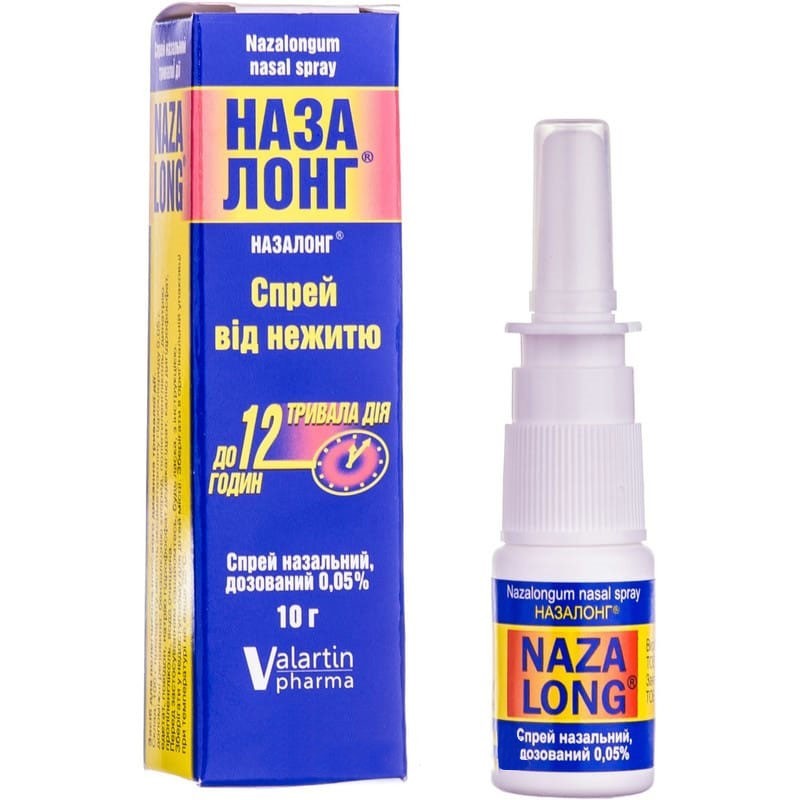



 Secure and encrypted payment processing
Secure and encrypted payment processing We ship to over 40 countries including the USA, UK, Europe, Australia and Japan
We ship to over 40 countries including the USA, UK, Europe, Australia and Japan Guaranteed refund or reship if you haven't received your order
Guaranteed refund or reship if you haven't received your orderNasalong spray is prescribed for the treatment of acute rhinitis (runny nose) of any origin: infectious, viral, vasomotor or allergic (hay fever). In the complex treatment of sinusitis, eustachitis, otitis media.
In order to facilitate rhinoscopy and surgical procedures in the nasal cavity.
active substance: oxymetazoline hydrochloride 100 g of the drug contain oxymetazoline hydrochloride in terms of 100% substance 0.05 g
excipients: benzalkonium chloride, polyethylene glycol, trilon B, propylene glycol, povidone, sodium phosphate dodecahydrate, potassium dihydrogen phosphate, purified water.
Nasalong ® It belongs to the group of local vasoconstrictors (decongensant). Oxymetazoline hydrochloride is a synthetic adrenomimetic and has an alpha-adrenomimetic effect.
Hypersensitivity to the components of the drug.
Atrophic rhinitis.
When using MAO inhibitors (MAO) and within 2 weeks after the cessation of treatment with MAO inhibitors, as well as other drugs that increase blood pressure.
With increased intraocular pressure, especially with angle-closure glaucoma.
In severe forms of cardiovascular disease (e.g. coronary heart disease, arterial hypertension).
Severe atherosclerosis, heart rhythm disturbance (e.g. tachycardia).
Pheochromocytoma.
Metabolic disorders (hyperthyroidism, thyrotoxicosis, diabetes mellitus, porphyria).
Hypertrophy of the prostate.
Exceeding recommended doses is not allowed. During pregnancy and lactation, the drug should be used with caution only after a thorough assessment of the risk / benefit ratio for the mother and the fetus / child.
The drug should not be used in children under 6 years of age.
After prolonged use of the drug in doses exceeding the recommended, one cannot exclude the general effect on the cardiovascular and nervous system. In such cases, the ability to drive a vehicle may be reduced.
1. Remove the protective cap. Before the first use of the drug, press the sprayer several times until a dispersed jet appears.
2. Insert the nebulizer into the nasal passage and do the injection by pressing the index and middle fingers fully against the nebulizer.
3. Make the required number of injections (see below) in each nasal passage; there is no need to throw your head back.
4. During injection, it is recommended to inhale easily through the nose, which will contribute to the optimal distribution of aerosol in the nasal cavity.
5. After use, close spray bottle with protective cap.
Adults are prescribed 1-2 injections, for children over 6 years of age - 1 injection in each nostril. The interval between applications of the drug should be at least 10-12 hours. The course of treatment is no more than 3-5 days.
After a significant overdose or accidental ingestion, the following symptoms may occur: mydriasis, nausea, vomiting, cyanosis, fever, cramps, tachycardia, palpitation, arrhythmia, cardiovascular failure, cardiac arrest, collapse, increased sweating, agitation, convulsions, hypertension , pulmonary edema, respiratory disorders, pallor, miosis, hyposmia, mental disorders.
In addition, excitement or inhibition of functions from the central nervous system may occur, manifested by drowsiness, decreased body temperature, bradycardia, arterial hypotension, apnea and the possible development of coma.
Therapeutic measures for overdose: gastric lavage, intake of activated carbon, ventilation of the lungs.With a decrease in blood pressure, use phentolamine. Do not take vasopressor drugs. If necessary, anticonvulsant therapy is indicated.
With frequent and prolonged use, there may be a burning sensation, tingling in the nose, flushing, sneezing, dryness of the nasal mucosa and / or mouth or throat. After the effect of the use of the drug is over - a feeling of severe nasal congestion (reactive hyperemia). Prolonged continuous use of vasoconstrictor drugs can lead to tachyphylaxis or the development of drug rhinitis. Apnea in infants and young children (especially in case of overdose).
From the cardiovascular system. Tachycardia, palpitation (palpitations), increased blood pressure, heart pain.
From the side of the organs of vision. Irritation, discomfort or redness of the eyes.
From the gastrointestinal tract. Nausea.
From the immune system. Allergic and hypersensitivity reactions may occur, including rash, itching, angioedema (Quinckes edema).
From the respiratory system. Discomfort or irritation in the nose, mouth and throat, as well as nosebleeds.
From the nervous system. Anxiety, irritability, sleep disturbance, insomnia, drowsiness, fatigue, headache, cramps, hallucinations (especially in children).
With the simultaneous administration of the drug with other vasoconstrictors (regardless of the method of administration), mutual reinforcement of side effects is possible. Slows down the absorption of local anesthetics and prolongs their effect. Enhances the effect of MAO inhibitors on the central nervous system. Due to the risk of high blood pressure, MAO inhibitors, tricyclic antidepressants and other drugs that increase blood pressure should not be used with Nazalong ® .
Store in the original packaging at a temperature not exceeding 25 ° C. Keep out of the reach of children.
Shelf life is 2 years.